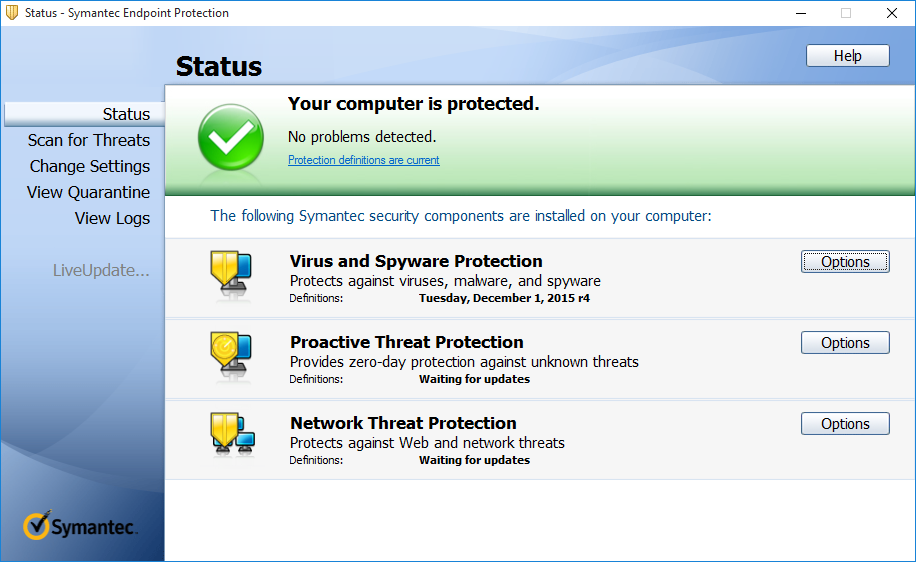Mac Microsoft Endpoint Protection

- Install System Center Endpoint Protection
- System Center Service Manager Discontinued
- Mac Microsoft Endpoint Protection 2016
Protect your Mac business devices with Endpoint Security for Mac OS X including antimalware, Anti-Phishing, Web control and firewall. Microsoft Defender and encryption For example, you can create an endpoint protection profile that only allows macOS users to install apps from the Mac App Store. Or, enable Windows SmartScreen when running apps on Windows 10 devices. The first thing you will need to do is download the latest Endpoint Protection clients for Mac and Linux. This is available from the Volume Licensing website. This should either be an ISO or a self-extracting.EXE. Jun 20, 2019 Microsoft Defender ATP integrates with Microsoft Information Protection to discover, protect, and monitor sensitive data on Windows devices. Microsoft Defender ATP, Microsoft’s endpoint protection platform, addresses this challenge by integrating with Azure Information Protection, Microsoft’s data classification, labeling, and protection solution. Create a macOS endpoint protection profile. Allow apps downloaded from these locations Limit the apps a device can launch, depending on where the apps were downloaded from. The intent is to protect devices from malware, and allow apps from only the sources you trust. Not configured; Mac App Store; Mac App Store and identified developers; Anywhere. Microsoft recently announced end of support for their Mac and Linux anti-virus (AV) product called Security Center Endpoint Protection or more commonly SCEP. Specifically, the Microsoft Tech Community announcement stated the following: End of Support for SCEP for Mac and SCEP for Linux on December 31, 2018. May 21, 2013 A1: System Center 2012 Endpoint Protection for Mac brings the protection, the smart proactive detection, and the small footprint of our ThreatSense® technology to the Mac. System Center 2012 Endpoint Protection for Mac helps protect you and your network from emerging and cross-platform (that is, Windows, Linux, and Mac) threats without system slowdowns.
With Intune, you can use device configuration profiles to manage common endpoint protection security features on devices, including:
- Firewall
- BitLocker
- Allowing and blocking apps
- Microsoft Defender and encryption
For example, you can create an endpoint protection profile that only allows macOS users to install apps from the Mac App Store. Or, enable Windows SmartScreen when running apps on Windows 10 devices.
Before you create a profile, review the following articles that detail the endpoint protection settings Intune can manage for each supported platform:
Note
The Intune user interface (UI) is updating to a full screen experience, and may take several weeks. Until your tenant receives this update, you will have a slightly different workflow when you create or edit settings described in this article.
Create a device profile containing endpoint protection settings
Sign in to the Microsoft Endpoint Manager admin center.
Select Devices > Configuration profiles > Create profile.
Enter the following properties:
Platform: Choose the platform of your devices. Your options:
A Mac can even run Windows.Have a Windows application you need to use once in a while? And everyone can work on the same document at the same time — from across town or across the globe. Is microsoft office for mac compatible with pc. Every new Mac lets you install and run Windows at native speeds, using a built-in utility called Boot Camp.Setup is simple and safe for your Mac files. After you’ve completed the installation, you can boot up your Mac using either macOS or Windows. You can also open, edit, and save Microsoft Word, Excel, and PowerPoint files with these apps, so you can easily work with others, regardless of whether they’re on a Mac or PC.
- macOS
- Windows 10 and later
Profile: Select Endpoint protection.
Select Create.
In Basics, enter the following properties:
- Name: Enter a descriptive name for the policy. Name your policies so you can easily identify them later. For example, a good policy name is macOS: Endpoint Protection profile that configures the Firewall for all macOS devices.
- Description: Enter a description for the policy. This setting is optional, but recommended.
Select Next.
In Configuration settings, depending on the platform you chose, the settings you can configure are different. Choose your platform for detailed settings:
Select Next.
In Scope tags (optional), assign a tag to filter the profile to specific IT groups, such as
US-NC IT TeamorJohnGlenn_ITDepartment. For more information about scope tags, see Use RBAC and scope tags for distributed IT.Select Next.
In Assignments, select the users or groups that will receive your profile. For more information on assigning profiles, see Assign user and device profiles.
Select Next.
In Review + create, review your settings. When you select Create, your changes are saved, and the profile is assigned. The policy is also shown in the profiles list.
Upgrade microsoft office 2008 for mac 12.3.7. Improvements that are included in the updateThe Office 2008 for Mac 12.2.5 Update includes the following improvements. It includes fixes for vulnerabilities that an attacker can use to overwrite the contents of your computer’s memory with malicious code. Additionally, this update contains improvements that enhance the stability and performance of Office 2008 for Mac applications.
Add custom Firewall rules for Windows 10 devices

When you configure the Microsoft Defender Firewall as part of a profile that includes endpoint protection rules for Windows 10, you can configure custom rules for Firewalls. Custom rules let you expand on the pre-defined set of Firewall rules supported for Windows 10.
When you plan for profiles with custom Firewall rules, consider the following information, which could affect how you choose to group firewall rules in your profiles:
Each profile supports up to 150 firewall rules. When you use more than 150 rules, create additional profiles, each limited to 150 rules.
For each profile, if a single rule fails to apply, all rules in that profile are failed and none of the rules are applied to the device.
When a rule fails to apply, all rules in the profile are reported as failed. Intune cannot identify which individual rule failed.
Install System Center Endpoint Protection
The Firewall rules that Intune can manage are detailed in the Windows Firewall configuration service provider (CSP). To review the list of custom firewall settings for Windows 10 devices that Intune supports, see Custom Firewall rules.
System Center Service Manager Discontinued
To add custom firewall rules to an Endpoint protection profile
Sign in to the Microsoft Endpoint Manager admin center.
Select Devices > Configuration profiles > Create Profile.
For Platform, select Windows 10 and later, and then for Profile select Endpoint protection.
Select Create.
Enter a Name for your profile > Next.
In Configuration settings, select Microsoft Defender Firewall. For Firewall rules, select Add to open the Create Rule page.
Specify settings for the Firewall rule, and then select OK to save it. To review the available custom firewall rule options in documentation, see Custom Firewall rules.
- The rule appears on the Microsoft Defender Firewall page in the list of rules.
- To modify a rule, select the rule from the list, to open the Edit Rule page.
- To delete a rule from a profile, select the ellipsis (…) for the rule, and then select Delete.
- To change the order in which rules display, select the up arrow, down arrow icon at the top of the rule list.
Select Next until you get to Review + create. When you select Create, your changes are saved and the profile is assigned. The policy is also shown in the profiles list.
Next steps
Mac Microsoft Endpoint Protection 2016
The profile is created, but it may not be doing anything yet. Next, assign the profile and monitor its status.